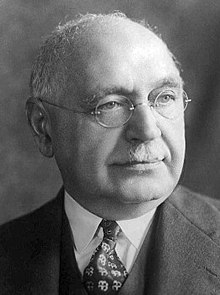Frank Schlesinger
Frank Schlesinger | |
|---|---|
 | |
| Born | May 11, 1871 |
| Died | July 10, 1943 (aged 72) |
| Nationality | American |
| Alma mater | Columbia University |
| Known for | Yale Bright Star Catalogue |
| Awards | Valz Prize (1926) Gold Medal of the Royal Astronomical Society (1927) Bruce Medal (1929) |
| Scientific career | |
| Fields | astronomy |
| Institutions | Yerkes Observatory |
Frank Schlesinger (May 11, 1871 New York City – July 10, 1943 Old Lyme, Connecticut) was an American astronomer. His work concentrated on using photographic plates rather than direct visual studies for astronomical research.
Biography
Schlesinger attended New York City public schools,[1] and graduated from the College of the City of New York in 1890. He then worked as a surveyor, becoming a special student in astronomy at Columbia in 1894. In 1896, he received a fellowship which enabled him to study full-time,[1] and he received a Ph.D. in 1898. After his graduation, he spent the summer at Yerkes Observatory as a volunteer assisting director George Ellery Hale.[2] He was an observer in charge of the International Latitude Observatory, Ukiah, California, in 1898. From 1899 to 1903, he was an astronomer at Yerkes, where he pioneered the use of photographic methods to determine stellar parallaxes. He was director of Allegheny Observatory from 1903 to 1920 and Yale University Observatory from 1920 to 1941.[3]
At Yale he worked extensively with Ida Barney[4] He compiled and published the Yale Bright Star Catalogue. The first publication of the results of this work started in 1925 (Transactions of the Yale University Observatory, v. 4) and the work concluded in the 1980s.[1] He made major contributions to astrometry. He was elected to the American Philosophical Society (1912), the National Academy of Sciences (1916) and the American Academy of Arts and Sciences and served as president of the American Astronomical Society (1919–1922), and the International Astronomical Union (1932–1935).[1][2]
Asked how to say his name, he told The Literary Digest "The name is so difficult for those who do not speak German that I am usually called sles'in-jer, to rime with messenger. It is, of course, of German origin and means 'a native of Schlesien' or Silesia. In that language the pronunciation is shlayzinger, to rime with singer."[5]
Awards and honors
- Valz Prize of the French Academy of Sciences (1926)[6]
- Gold Medal of the Royal Astronomical Society (1927)
- Bruce Medal (1929)
- The crater Schlesinger on the Moon is named after him, as is the asteroid 1770 Schlesinger.
Family
He married Eva Hirsch in 1900 while in Ukiah. They had one child, Frank Wagner Schlesinger, who later directed planetariums in Philadelphia and Chicago. His wife died in 1928, and in 1929 he married Mrs. Katherine Bell (Rawling) Wilcox.[2]
Published works
- Barney, Ida; Schlesinger, Frank (1938). "An effect of a star's color upon its apparent photographic position". Astronomical Journal. 47. Bibcode:1938AJ.....47...86B. doi:10.1086/105478.
- Barney, Ida; Schlesinger, Frank (1939). "On the accuracy of the proper motions in the General Catalogue Albany". Astronomical Journal. 48. Bibcode:1939AJ.....48...51B. doi:10.1086/105546.
- Barney, Ida; Schlesinger, Frank (1940). "New reductions of astrographic plates with the help of the Yale photographic Catalogues". Astronomical Journal. 49. Bibcode:1940AJ.....49...39B. doi:10.1086/105625.
Notes
- ^ a b c d Peggy Aldrich Kidwell (1999). "Schlesinger, Frank". American National Biography. New York: Oxford University Press.
- ^ a b c Peter van de Kamp (1973). "Schlesinger, Frank". Dictionary of American Biography. Vol. Supplement Three 1941-1945. New York: Charles Scribner's Sons.
- ^ "The Bruce Medalists: Frank Schlesinger". phys-astro.sonoma.edu. 2013-01-24. Retrieved 2013-06-13.
- ^ Hoffleit, E. Dorrit (June 1990). "Ida M. Barney, Ace Astrometrist" (PDF). STATUS: The Committee on the Status of Women in Astronomy. American Astronomical Society. Retrieved 17 November 2012.
- ^ Charles Earle Funk, What's the Name, Please?, Funk & Wagnalls, 1936.
- ^ "General Notes". Popular Astronomy. 1927. p. 242.
References
- This article incorporates text from a publication now in the public domain: Rines, George Edwin, ed. (1920). . Encyclopedia Americana.
Further reading
- Hockey, Thomas (2009). "Frank Schleisinger". The Biographical Encyclopedia of Astronomers. Springer Publishing. ISBN 978-0-387-31022-0. Retrieved August 22, 2012. (subscription required)
